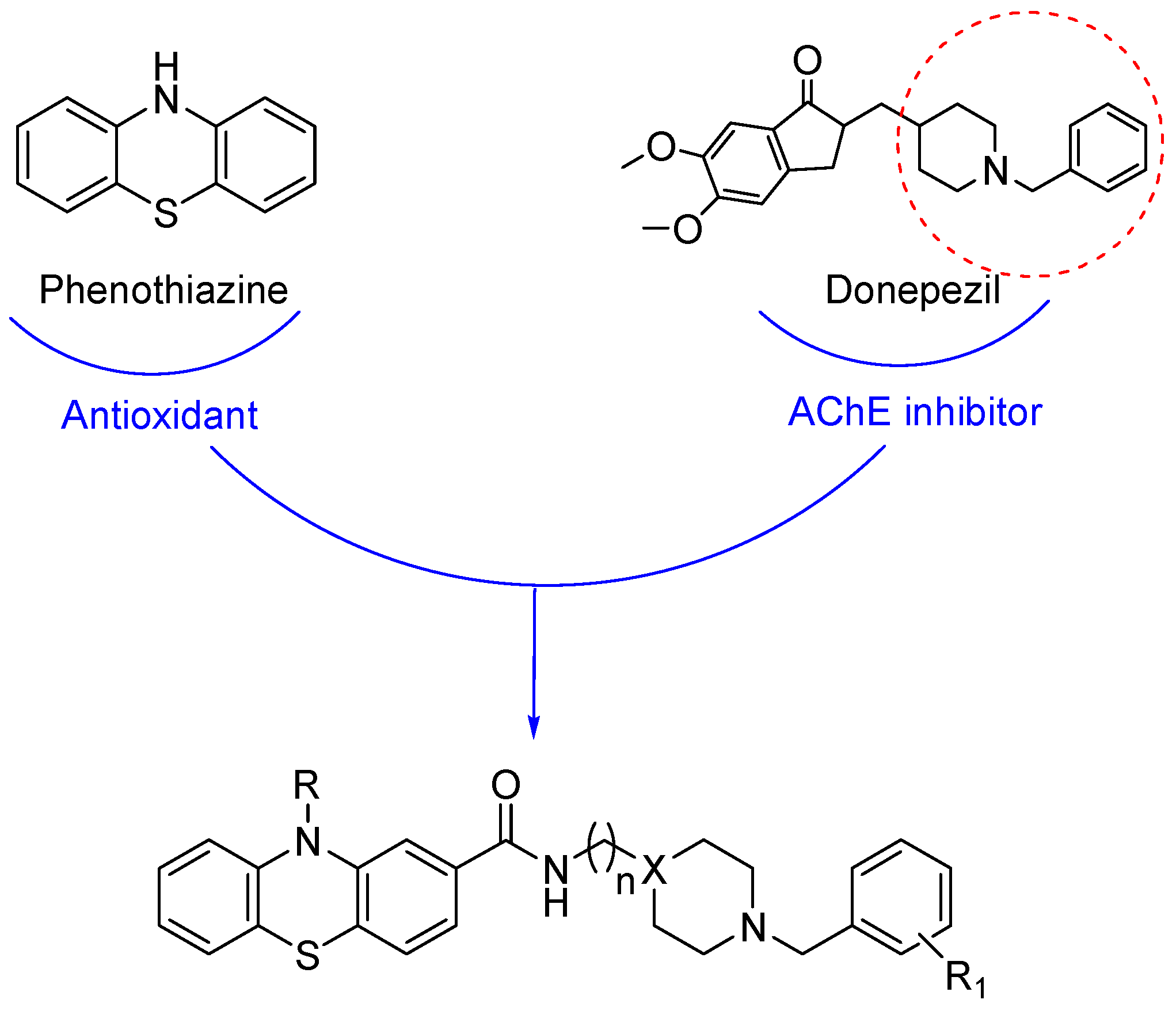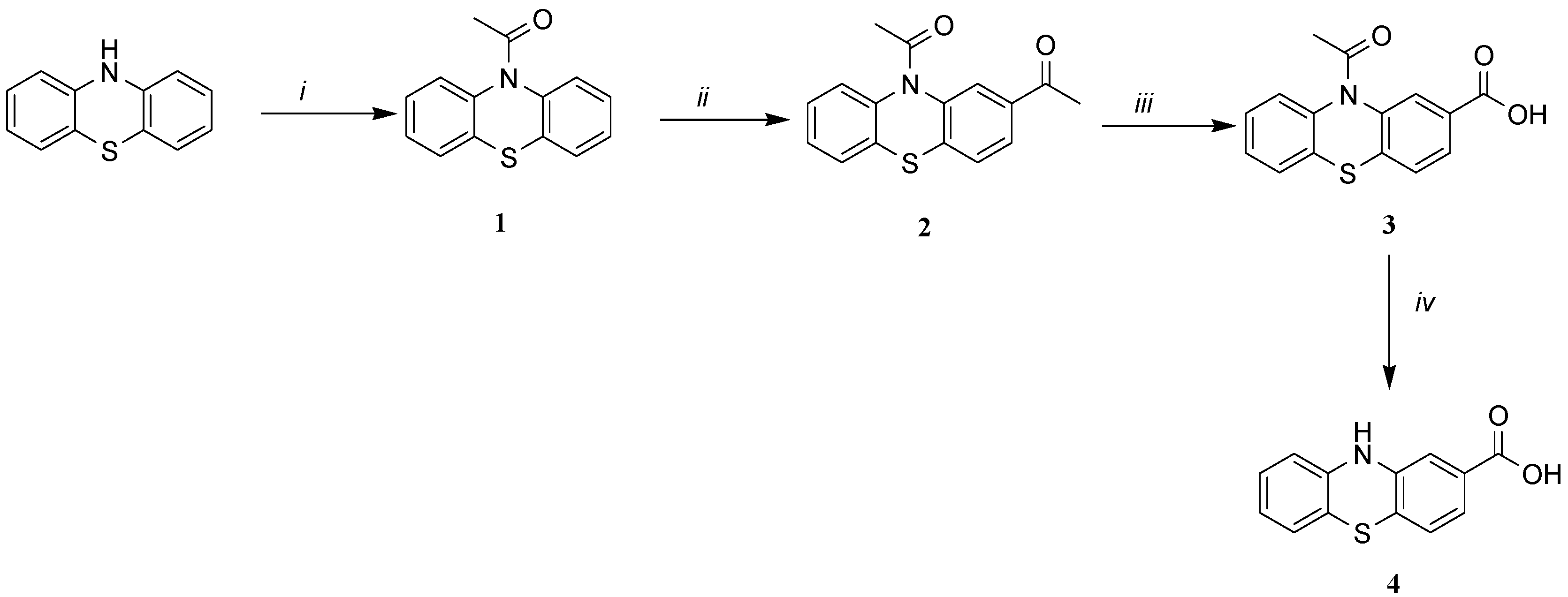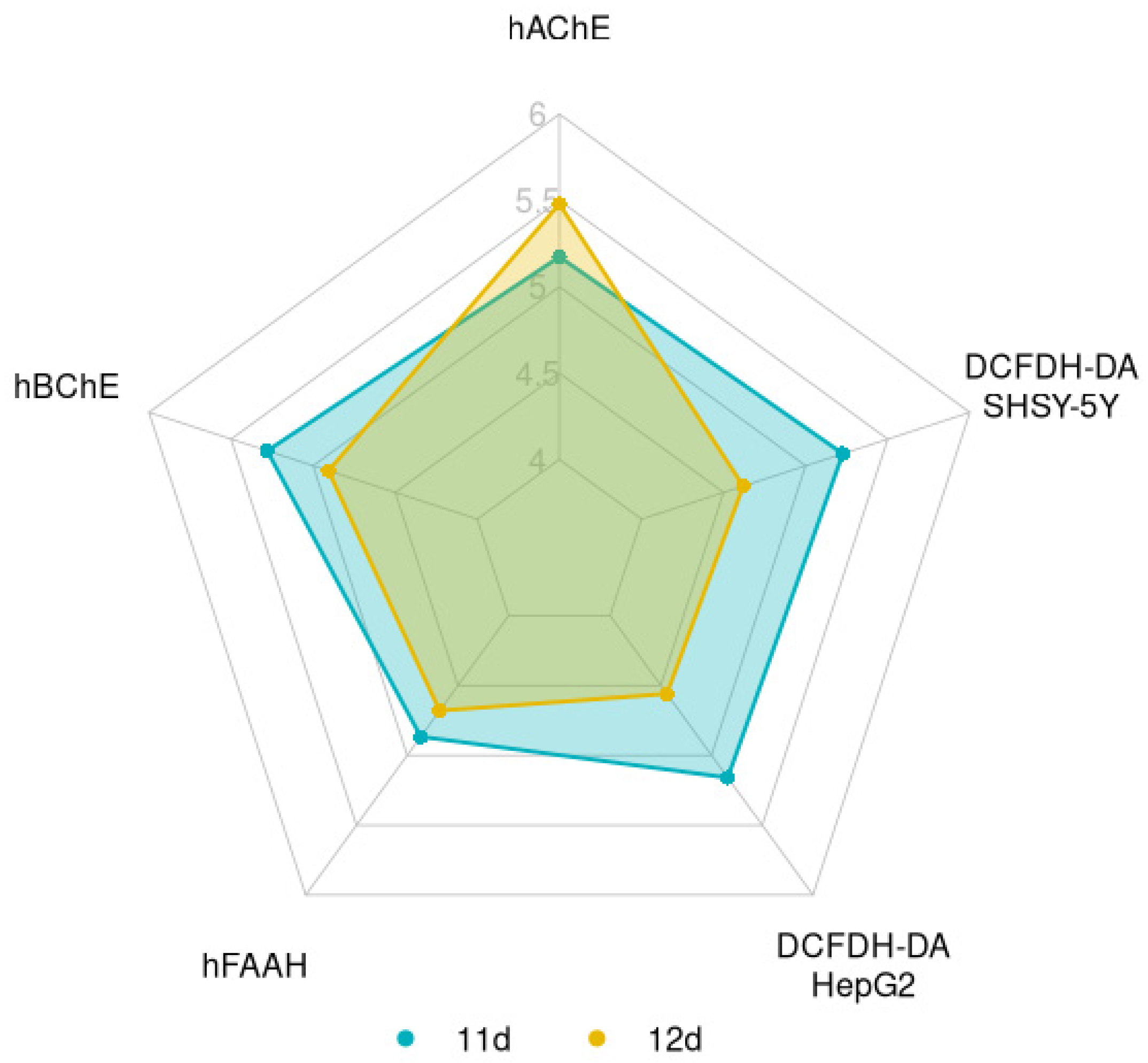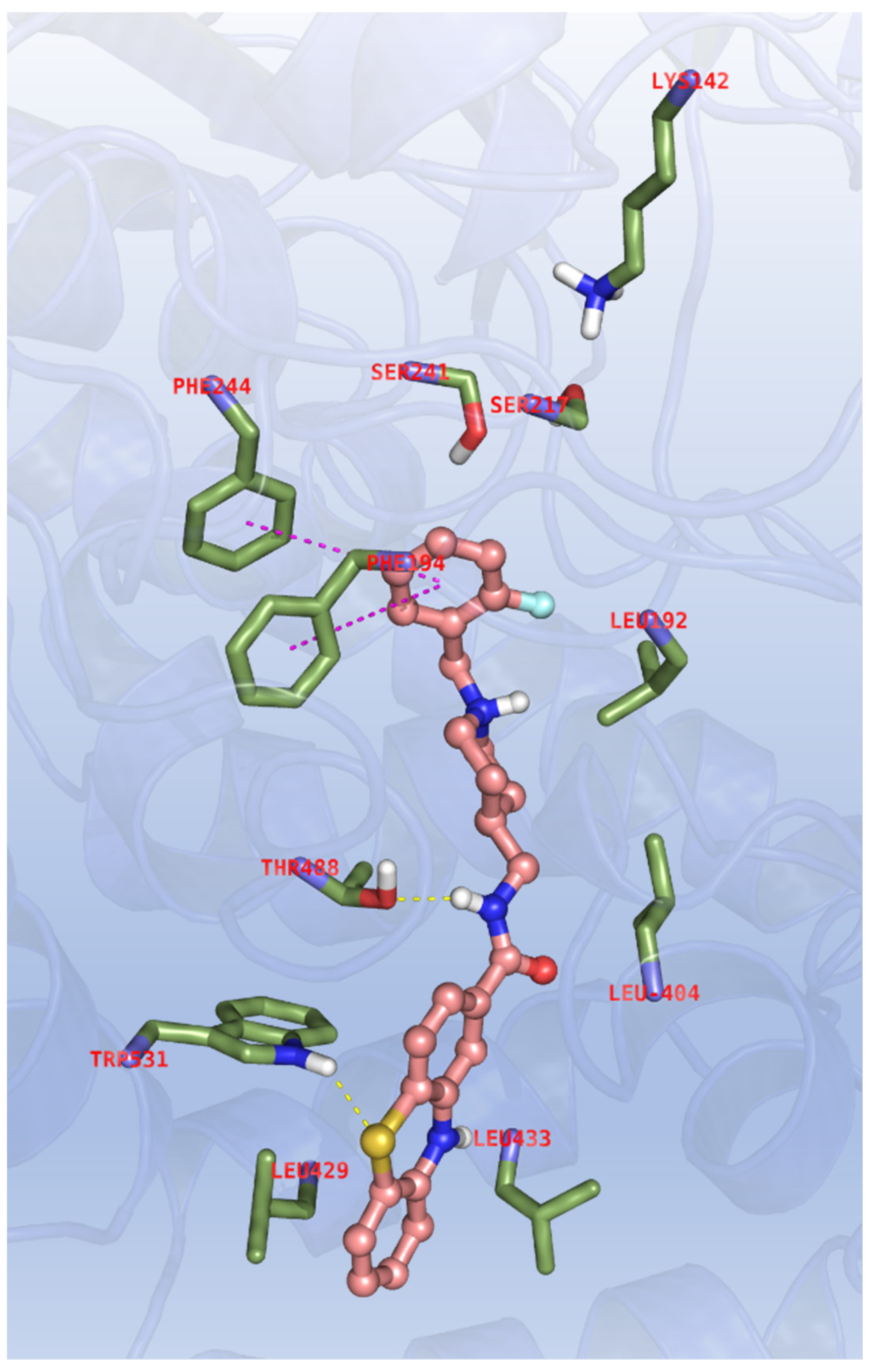Novel Phenothiazine/Donepezil-like Hybrids Endowed with Antioxidant Activity for a Multi-Target Approach to the Therapy of Alzheimer’s Disease
Abstract
:1. Introduction
2. Materials and Methods
2.1. Chemistry
2.1.1. Preparation of 1-(10H-phenothiazin-10-yl)ethenone (1)
2.1.2. Preparation of 1,1′-(10H-phenothiazine-2,10-diyl)diethanone (2)
2.1.3. Preparation of 10-acetyl-10H-phenothiazine-2-carboxylic Acid (3) and 10H-phenothiazine-2-carboxylic Acid (4)
10-Acetyl-10H-phenothiazine-2-carboxylic Acid (3)
10H-phenothiazine-2-carboxylic Acid (4)
2.1.4. Preparation of 2-(piperidin-4-ylmethyl)isoindoline-1,3-dione (5)
2.1.5. General Procedure for the Preparation of 2-((1-benzylpiperidin-4-yl)methyl)isoindoline-1,3-dione Derivatives (7a–e)
2-((1-Benzylpiperidin-4-yl)methyl)isoindoline-1,3-dione (7a)
2-((1-(2-Chlorobenzyl)piperidin-4-yl)methyl)isoindoline-1,3-dione (7b)
2-((1-(2-Methylbenzyl)piperidin-4-yl)methyl)isoindoline-1,3-dione (7c)
2-((1-(2-Fluorobenzyl)piperidin-4-yl)methyl)isoindoline-1,3-dione (7d)
2-((1-(3-Methoxybenzyl)piperidin-4-yl)methyl)isoindoline-1,3-dione (7e)
General Procedure for the Preparation of 2-(2-(4-Benzylpiperazin-1-yl)ethyl)isoindoline-1,3-dione Derivatives (8a–e)
2-(2-(4-Benzylpiperazin-1-yl)ethyl)isoindoline-1,3-dione (8a)
2-(2-(4-(2-Chlorobenzyl)piperazin-1-yl)ethyl)isoindoline-1,3-dione (8b)
2-(2-(4-(2-Methylbenzyl)piperazin-1-yl)ethyl)isoindoline-1,3-dione (8c)
2-(2-(4-(2-Fluorobenzyl)piperazin-1-yl)ethyl)isoindoline-1,3-dione (8d)
2-(2-(4-(2-Methoxybenzyl)piperazin-1-yl)ethyl)isoindoline-1,3-dione (8e)
2.1.6. General Procedure for the Preparation of Free Amines 9a–e and 10a–e
(1-Benzylpiperidin-4-yl)methanamine (9a)
(1-(2-Chlorobenzyl)piperidin-4-yl)methanamine (9b)
(1-(2-Methylbenzyl)piperidin-4-yl)methanamine (9c)
(1-(2-Fluorobenzyl)piperidin-4-yl)methanamine (9d)
(1-(3-Methoxybenzyl)piperidin-4-yl)methanamine (9e)
2-(4-Benzyl-1-piperazine-1-yl)ethanamine (10a)
2-(4-(2-Chlorobenzyl)piperazine-1-yl)ethanamine (10b)
2-(4-(2-Methylbenzyl)piperazine-1-yl)ethanamine (10c)
2-(4-(2-Fluorobenzyl)piperazine-1-yl)ethanamine (10d)
2-(4-(3-Methoxylbenzyl)piperazine-1-yl)ethanamine (10e)
2.1.7. General Procedure for the Preparation of the Final Amides 11a–e, 12a–e and 13
N-((1-Benzylpiperidin-4-yl)methyl)-10H-phenothiazine-2-carboxamide (11a)
N-((1-(2-Chlorobenzyl)piperidin-4-yl)methyl)-10H-phenothiazine-2-carboxamide (11b)
N-((1-(2-Methylbenzyl)piperidin-4-yl)methyl)-10H-phenothiazine-2-carboxamide (11c)
N-((1-(2-Fluorobenzyl)piperidin-4-yl)methyl)-10H-phenothiazine-2-carboxamide (11d)
N-((1-(3-Methoxybenzyl)piperidin-4-yl)methyl)-10H-phenothiazine-2-carboxamide (11e)
N-(2-(4-Benzylpiperazin-1-yl)ethyl)-10H-phenothiazine-2-carboxamide (12a)
N-(2-(4-(2-Chlorobenzyl)piperazin-1-yl)ethyl)-10H-phenothiazine-2-carboxamide (12b)
N-(2-(4-(2-Methylbenzyl)piperazin-1-yl)ethyl)-10H-phenothiazine-2-carboxamide (12c)
N-(2-(4-(2-Fluorobenzyl)piperazin-1-yl)ethyl)-10H-phenothiazine-2-carboxamide (12d)
N-(2-(4-(2-Methoxybenzyl)piperazin-1-yl)ethyl)-10H-phenothiazine-2-carboxamide (12e)
10-Acetyl-N-(2-(4-(2-chlorobenzyl)piperazin-1-yl)ethyl)-10H-phenothiazine-2-carboxamide (13)
2.2. Biological Methods
2.2.1. AChE and BChE Inhibition
2.2.2. Inhibition of Aβ40 Aggregation
2.2.3. FAAH Inhibition
2.2.4. DPPH Assay
2.2.5. Cultured Cells
2.2.6. Dichlorofluorescein Assay
2.2.7. Cell Viability Assay
2.3. Computational Methods
2.3.1. Docking Studies
2.3.2. Prediction of Pharmacokinetic Properties
3. Results and Discussion
3.1. Chemistry
3.2. Biological Assays
3.2.1. ChEs, FAAH, Aβ1-40 Aggregation Inhibition
3.2.2. Antioxidant Activity
3.2.3. Multi-Target Profiles
3.3. Molecular Docking Calculations
3.4. ADME Properties
4. Conclusions
Supplementary Materials
Author Contributions
Funding
Institutional Review Board Statement
Informed Consent Statement
Data Availability Statement
Acknowledgments
Conflicts of Interest
References
- Wakhloo, D.; Oberhauser, J.; Madira, A.; Mahajani, S. From cradle to grave: Neurogenesis, neuroregeneration and neurodegeneration in Alzheimer’s and Parkinson’s diseases. Neural Regen. Res. 2022, 17, 2606–2614. [Google Scholar] [CrossRef] [PubMed]
- Auten, R.L.; Davis, J.M. Oxygen Toxicity and Reactive Oxygen Species: The Devil Is in the Details. Pediatr. Res. 2009, 66, 121–127. [Google Scholar] [CrossRef]
- Iacopetta, D.; Catalano, A.; Ceramella, J.; Barbarossa, A.; Carocci, A.; Fazio, A.; La Torre, C.; Caruso, A.; Ponassi, M.; Rosano, C.; et al. Synthesis, anticancer and antioxidant properties of new indole and pyranoindole derivatives. Bioorg. Chem. 2020, 105, 104440. [Google Scholar] [CrossRef] [PubMed]
- Carocci, A.; Roselli, M.; Budriesi, R.; Micucci, M.; Desaphy, J.F.; Altamura, C.; Cavalluzzi, M.M.; Toma, M.; Passeri, G.I.; Milani, G.; et al. Synthesis and Evaluation of Voltage-Gated Sodium Channel Blocking Pyrroline Derivatives Endowed with Both Antiarrhythmic and Antioxidant Activities. ChemMedChem 2021, 16, 578–588. [Google Scholar] [CrossRef]
- De Bellis, M.; Sanarica, F.; Carocci, A.; Lentini, G.; Pierno, S.; Rolland, J.-F.; Camerino, D.C.; De Luca, A. Dual Action of Mexiletine and Its Pyrroline Derivatives as Skeletal Muscle Sodium Channel Blockers and Anti-oxidant Compounds: Toward Novel Therapeutic Potential. Front. Pharmacol. 2018, 8, 907. [Google Scholar] [CrossRef]
- Sindhu, R.K.; Kaur, P.; Kaur, P.; Singh, H.; Batiha, G.E.-S.; Verma, I. Exploring multifunctional antioxidants as potential agents for management of neurological disorders. Environ. Sci. Pollut. Res. 2022, 29, 24458–24477. [Google Scholar] [CrossRef] [PubMed]
- Piemontese, L.; Loiodice, F.; Chaves, S.; Santos, M.A. The Therapy of Alzheimer’s Disease: Towards a New Generation of Drugs. In Frontiers in Clinical Drug Research—Alzheimer Disorders; Bentham Science Publishers: Dubai, United Arab Emirates, 2019; Volume 8, pp. 33–80. ISBN 3908054427. [Google Scholar]
- Cuadrado, A.; Kügler, S.; Lastres-Becker, I. Pharmacological targeting of GSK-3 and NRF2 provides neuroprotection in a preclinical model of tauopathy. Redox Biol. 2018, 14, 522–534. [Google Scholar] [CrossRef]
- Saha, S.; Buttari, B.; Panieri, E.; Profumo, E.; Saso, L. An Overview of Nrf2 Signaling Pathway and Its Role in Inflammation. Molecules 2020, 25, 5474. [Google Scholar] [CrossRef]
- Piemontese, L. An innovative approach for the treatment of Alzheimer’s disease: The role of peroxisome proliferator-activated receptors and their ligands in development of alternative therapeutic interventions. Neural Regen. Res. 2019, 14, 43–45. [Google Scholar] [CrossRef]
- Available online: https://www.fda.gov/drugs/postmarket-drug-safety-information-patients-and-providers/aducanumab-marketed-aduhelm-information (accessed on 28 June 2022).
- Available online: https://www.ema.europa.eu/en/medicines/human/withdrawn-applications/aduhelm#key-facts (accessed on 28 June 2022).
- Brunetti, L.; Leuci, R.; Carrieri, A.; Catto, M.; Occhineri, S.; Vinci, G.; Gambacorta, L.; Baltrukevich, H.; Chaves, S.; Laghezza, A.; et al. Structure-based design of novel donepezil-like hybrids for a multi-target approach to the therapy of Alzheimer’s disease. Eur. J. Med. Chem. 2022, 237, 114358. [Google Scholar] [CrossRef]
- Brunetti, L.; Laghezza, A.; Loiodice, F.; Tortorella, P.; Piemontese, L. Combining fatty acid amide hydrolase (FAAH) inhibition with peroxisome proliferator-activated receptor (PPAR) activation: A new potential multi-target therapeutic strategy for the treatment of Alzheimer’s disease. Neural Regen. Res. 2020, 15, 67–68. [Google Scholar] [CrossRef] [PubMed]
- Leuci, R.; Brunetti, L.; Laghezza, A.; Piemontese, L.; Carrieri, A.; Pisani, L.; Tortorella, P.; Catto, M.; Loiodice, F. A New Series of Aryloxyacetic Acids Endowed with Multi-Target Activity towards Peroxisome Proliferator-Activated Receptors (PPARs), Fatty Acid Amide Hydrolase (FAAH), and Acetylcholinesterase (AChE). Molecules 2022, 27, 958. [Google Scholar] [CrossRef] [PubMed]
- Piemontese, L.; Vitucci, G.; Catto, M.; Laghezza, A.; Perna, F.M.; Rullo, M.; Loiodice, F.; Capriati, V.; Solfrizzo, M. Natural scaffolds with multi-target activity for the potential treatment of Alzheimer’s disease. Molecules 2018, 23, 2182. [Google Scholar] [CrossRef] [PubMed]
- Poliseno, V.; Chaves, S.; Brunetti, L.; Loiodice, F.; Carrieri, A.; Laghezza, A.; Tortorella, P.; Magalhães, J.D.; Cardoso, S.M.; Santos, M.A.; et al. Derivatives of Tenuazonic Acid as Potential New Multi-Target Anti-Alzheimer’s Disease Agents. Biomolecules 2021, 11, 111. [Google Scholar] [CrossRef]
- Chaves, S.; Resta, S.; Rinaldo, F.; Costa, M.; Josselin, R.; Gwizdala, K.; Piemontese, L.; Capriati, V.; Pereira-Santos, A.R.; Cardoso, S.M.; et al. Design, synthesis, and in vitro evaluation of hydroxybenzimidazole-donepezil analogues as multitarget-directed ligands for the treatment of Alzheimer’s disease. Molecules 2020, 25, 985. [Google Scholar] [CrossRef]
- Piemontese, L.; Tomás, D.; Hiremathad, A.; Capriati, V.; Candeias, E.; Cardoso, S.M.; Chaves, S.; Santos, M.A. Donepezil structure-based hybrids as potential multifunctional anti-Alzheimer’s drug candidates. J. Enzyme Inhib. Med. Chem. 2018, 33, 1212–1224. [Google Scholar] [CrossRef]
- Piemontese, L.; Sergio, R.; Rinaldo, F.; Brunetti, L.; Perna, F.M.; Santos, M.A.; Capriati, V. Deep Eutectic Solvents as Effective Reaction Media for the Synthesis of 2-Hydroxyphenylbenzimidazole-based Scaffolds en Route to Donepezil-Like Compounds. Molecules 2020, 25, 574. [Google Scholar] [CrossRef]
- Murphy, C.M.; Ravner, H.; Smith, N.L. Mode of Action of Phenothiazine-Type Antioxidants. Ind. Eng. Chem. 1950, 42, 2479–2489. [Google Scholar] [CrossRef]
- O’Leary, J.C.; Li, Q.; Marinec, P.; Blair, L.J.; Congdon, E.E.; Johnson, A.G.; Jinwal, U.K.; Koren, J.; Jones, J.R.; Kraft, C.; et al. Phenothiazine-mediated rescue of cognition in tau transgenic mice requires neuroprotection and reduced soluble tau burden. Mol. Neurodegener. 2010, 5, 45. [Google Scholar] [CrossRef]
- Gorecki, L.; Uliassi, E.; Bartolini, M.; Janockova, J.; Hrabinova, M.; Hepnarova, V.; Prchal, L.; Muckova, L.; Pejchal, J.; Karasova, J.Z.; et al. Phenothiazine-Tacrine Heterodimers: Pursuing Multitarget Directed Approach in Alzheimer’s Disease. ACS Chem. Neurosci. 2021, 12, 1698–1715. [Google Scholar] [CrossRef]
- Hui, A.; Chen, Y.; Zhu, S.; Gan, C.; Pan, J.; Zhou, A. Design and synthesis of tacrine-phenothiazine hybrids as multitarget drugs for Alzheimer’s disease. Med. Chem. Res. 2014, 23, 3546–3557. [Google Scholar] [CrossRef]
- Navarro, L.; Rosell, G.; Sánchez, S.; Boixareu, N.; Pors, K.; Pouplana, R.; Campanera, J.M.; Pujol, M.D. Synthesis and biological properties of aryl methyl sulfones. Bioorg. Med. Chem. 2018, 26, 4113–4126. [Google Scholar] [CrossRef] [PubMed]
- Chan, C.; Yin, H.; Garforth, J.; McKie, J.H.; Jaouhari, R.; Speers, P.; Douglas, K.T.; Rock, P.J.; Yardley, V.; Croft, S.L.; et al. Phenothiazine Inhibitors of Trypanothione Reductase as Potential Antitrypanosomal and Antileishmanial Drugs. J. Med. Chem. 1998, 41, 148–156. [Google Scholar] [CrossRef] [PubMed]
- Adlere, I.; Sun, S.; Zarca, A.; Roumen, L.; Gozelle, M.; Viciano, C.P.; Caspar, B.; Arimont, M.; Bebelman, J.P.; Briddon, S.J.; et al. Structure-based exploration and pharmacological evaluation of N-substituted piperidin-4-yl-methanamine CXCR4 chemokine receptor antagonists. Eur. J. Med. Chem. 2019, 162, 631–649. [Google Scholar] [CrossRef] [PubMed]
- Sang, Z.; Liu, W.; Yu, L.; Ma, Q.; Chen, Z.; Pan, W.; Li, T.; Gaoli, M. Cyclamine Alkylamide Ferulate Compound as well as Preparation Method and Application Thereof. CN105777614A, 20 July 2016. [Google Scholar]
- Ellman, G.L.; Courtney, K.D.; Andres, V.; Featherstone, R.M. A new and rapid colorimetric determination of acetylcholinesterase activity. Biochem. Pharmacol. 1961, 7, 88–95. [Google Scholar] [CrossRef]
- Pisani, L.; De Palma, A.; Giangregorio, N.; Miniero, D.V.; Pesce, P.; Nicolotti, O.; Campagna, F.; Altomare, C.D.; Catto, M. Mannich base approach to 5-methoxyisatin 3-(4-isopropylphenyl)hydrazone: A water-soluble prodrug for a multitarget inhibition of cholinesterases, beta-amyloid fibrillization and oligomer-induced cytotoxicity. Eur. J. Pharm. Sci. 2017, 109, 381–388. [Google Scholar] [CrossRef]
- Blois, M.S. Antioxidant Determinations by the Use of a Stable Free Radical. Nature 1958, 181, 1199–1200. [Google Scholar] [CrossRef]
- Mishra, K.; Ojha, H.; Chaudhury, N.K. Estimation of antiradical properties of antioxidants using DPPH assay: A critical review and results. Food Chem. 2012, 130, 1036–1043. [Google Scholar] [CrossRef]
- Wang, H.; Joseph, J.A. Quantifying cellular oxidative stress by dichlorofluorescein assay using microplate reader11Mention of a trade name, proprietary product, or specific equipment does not constitute a guarantee by the United States Department of Agriculture and does not imp. Free Radic. Biol. Med. 1999, 27, 612–616. [Google Scholar] [CrossRef]
- Berridge, M.V.; Tan, A.S. Characterization of the Cellular Reduction of 3-(4,5-dimethylthiazol-2-yl)-2,5-diphenyltetrazolium bromide (MTT): Subcellular Localization, Substrate Dependence, and Involvement of Mitochondrial Electron Transport in MTT Reduction. Arch. Biochem. Biophys. 1993, 303, 474–482. [Google Scholar] [CrossRef]
- Gerlits, O.; Ho, K.Y.; Cheng, X.; Blumenthal, D.; Taylor, P.; Kovalevsky, A.; Radić, Z. A new crystal form of human acetylcholinesterase for exploratory room-temperature crystallography studies. Chem. Biol. Interact. 2019, 309, 108698. [Google Scholar] [CrossRef] [PubMed]
- Pasieka, A.; Panek, D.; Jończyk, J.; Godyń, J.; Szałaj, N.; Latacz, G.; Tabor, J.; Mezeiova, E.; Chantegreil, F.; Dias, J.; et al. Discovery of multifunctional anti-Alzheimer’s agents with a unique mechanism of action including inhibition of the enzyme butyrylcholinesterase and γ-aminobutyric acid transporters. Eur. J. Med. Chem. 2021, 218, 113397. [Google Scholar] [CrossRef] [PubMed]
- Bertolacci, L.; Romeo, E.; Veronesi, M.; Magotti, P.; Albani, C.; Dionisi, M.; Lambruschini, C.; Scarpelli, R.; Cavalli, A.; De Vivo, M.; et al. A Binding Site for Nonsteroidal Anti-inflammatory Drugs in Fatty Acid Amide Hydrolase. J. Am. Chem. Soc. 2013, 135, 22–25. [Google Scholar] [CrossRef] [PubMed]
- Cornell, W.D.; Cieplak, P.; Bayly, C.I.; Gould, I.R.; Merz, K.M.; Ferguson, D.M.; Spellmeyer, D.C.; Fox, T.; Caldwell, J.W.; Kollman, P.A. A Second Generation Force Field for the Simulation of Proteins, Nucleic Acids, and Organic Molecules. J. Am. Chem. Soc. 1995, 117, 5179–5197. [Google Scholar] [CrossRef]
- Schrödinger LLC. Maestro. Schrödinger Release 2021-1. 2021. Available online: https://www.schrodinger.com/citations (accessed on 16 January 2022).
- OpenEye Scientific Software. QUACPAC; 2.1.0.4; OpenEye Scientific Software: Santa Fe, NM, USA, 2020; Available online: https://www.eyesopen.com (accessed on 28 June 2022).
- O’Boyle, N.M.; Banck, M.; James, C.A.; Morley, C.; Vandermeersch, T.; Hutchison, G.R. Open Babel: An Open chemical toolbox. J. Cheminform. 2011, 3, 33. [Google Scholar] [CrossRef]
- Morris, G.M.; Goodsell, D.S.; Halliday, R.S.; Huey, R.; Hart, W.E.; Belew, R.K.; Olson, A.J. Automated docking using a Lamarckian genetic algorithm and an empirical binding free energy function. J. Comput. Chem. 1998, 19, 1639–1662. [Google Scholar] [CrossRef]
- Khoury, L.E.; Santos-Martins, D.; Sasmal, S.; Eberhardt, J.; Bianco, G.; Ambrosio, F.A.; Solis-Vasquez, L.; Koch, A.; Forli, S.; Mobley, D.L. Comparison of affinity ranking using AutoDock-GPU and MM-GBSA scores for BACE-1 inhibitors in the D3R Grand Challenge 4. J. Comput. Aided Mol. Des. 2019, 33, 1011–1020. [Google Scholar] [CrossRef]
- Forli, S.; Olson, A.J. A force field with discrete displaceable waters and desolvation entropy for hydrated ligand docking. J. Med. Chem. 2012, 55, 623–638. [Google Scholar] [CrossRef]
- OpenEye Scientific Software. ROCS; 3.4.0.4; OpenEye Scientific Software: Santa Fe, NM, USA, 2020; Available online: http://www.eyesopen.com (accessed on 28 June 2022).
- QikProp; 2.5; Schrödinger: New York, NY, USA, 2005.
- Auvin, S.; de Lassauniere, P.-E.C. Novel Derivatives of 2-Hydroxytetrahydrofuran and Their Use as Medicaments. US20050222045A1, 10 June 2008. [Google Scholar]
- Queda, F.; Calò, S.; Gwizdala, K.; Magalhães, J.D.; Cardoso, S.M.; Chaves, S.; Piemontese, L.; Santos, M.A. Novel Donepezil–Arylsulfonamide Hybrids as Multitarget-Directed Ligands for Potential Treatment of Alzheimer’s Disease. Molecules 2021, 26, 1658. [Google Scholar] [CrossRef]
- Valeur, E.; Bradley, M. Amide bond formation: Beyond the myth of coupling reagents. Chem. Soc. Rev. 2009, 38, 606–631. [Google Scholar] [CrossRef]
- Carocci, A.; Catalano, A.; Bruno, C.; Lovece, A.; Roselli, M.G.; Cavalluzzi, M.M.; De Santis, F.; De Palma, A.; Rusciano, M.R.; Illario, M.; et al. N-(Phenoxyalkyl)amides as MT1 and MT2 ligands: Antioxidant properties and inhibition of Ca2+/CaM-dependent kinase II. Bioorg. Med. Chem. 2013, 21, 847–851. [Google Scholar] [CrossRef] [PubMed]
- Catalano, A.; Desaphy, J.-F.; Lentini, G.; Carocci, A.; Di Mola, A.; Bruno, C.; Carbonara, R.; De Palma, A.; Budriesi, R.; Ghelardini, C.; et al. Synthesis and Toxicopharmacological Evaluation of m -Hydroxymexiletine, the First Metabolite of Mexiletine More Potent Than the Parent Compound on Voltage-Gated Sodium Channels. J. Med. Chem. 2012, 55, 1418–1422. [Google Scholar] [CrossRef] [PubMed]
- Rossi, M.; Freschi, M.; Nascente, L.d.C.; Salerno, A.; Teixeira, S.d.M.V.; Nachon, F.; Chantegreil, F.; Soukup, O.; Prchal, L.; Malaguti, M.; et al. Sustainable Drug Discovery of Multi-Target-Directed Ligands for Alzheimer’s Disease. J. Med. Chem. 2021, 64, 4972–4990. [Google Scholar] [CrossRef] [PubMed]
- Daina, A.; Zoete, V. A BOILED-Egg To Predict Gastrointestinal Absorption and Brain Penetration of Small Molecules. ChemMedChem 2016, 11, 1117–1121. [Google Scholar] [CrossRef]
- Pajouhesh, H.; Lenz, G.R. Medicinal chemical properties of successful central nervous system drugs. NeuroRx 2005, 2, 541–553. [Google Scholar] [CrossRef]








| Compound | X | n | R | R1 | hAChE (IC50, µM) a | hBChE (IC50, µM) a | Aβ1-40 Aggregation (I% at 10 µM) a | hFAAH (IC50, µM) a |
|---|---|---|---|---|---|---|---|---|
| 11a | CH | 1 | H | H | 0.597 ± 0.064 | 2.16 ± 0.27 | 8% ± 5 | 22.6 ± 1.6 |
| 11b | CH | 1 | H | 2-Cl | 52% ± 1 b | 1.98 ± 0.12 | 20% ± 5 | 3.80 ± 0.90 |
| 11c | CH | 1 | H | 2-CH3 | 44% ± 2 b | 1.47 ± 0.03 | 47% ± 6 | 3.08 ± 0.44 |
| 11d | CH | 1 | H | 2-F | 1.75 ± 0.11 | 1.20 ± 0.01 | 43% ± 3 | 5.06 ± 0.40 |
| 11e | CH | 1 | H | 3-OCH3 | 22% ± 4 b | 47% ± 1 b | 24% ± 6 | 13.0 ± 3.4 |
| 12a | N | 2 | H | H | 0.943 ± 0.046 | 2.02 ± 0.03 | 43% ± 6 | 41.4 ± 0.90 |
| 12b | N | 2 | H | 2-Cl | 1.85 ± 0.15 | 27% ± 2 b | 27% ± 6 | 6.31 ± 1.28 |
| 12c | N | 2 | H | 2-CH3 | 56% ± 3 b | 2.50 ± 0.06 | n.a. | 7.33 ± 0.86 |
| 12d | N | 2 | H | 2-F | 0.599 ± 0.112 | 4.33 ± 0.19 | 60% ± 6 | 9.65 ± 2.45 |
| 12e | N | 2 | H | 3-OCH3 | 48% ± 3 b | 6.70 ± 0.05 | 23% ± 6 | 8.65 ± 2.93 |
| 13 | N | 2 | COCH3 | 2-Cl | 48% ± 5 b | 15% ± 3 b | n.a. | 16.9 ± 4.4 |
| Donepezil | 0.017 ± 0.002 | 4.80 ± 1.00 | 14% ± 7 | n.d. | ||||
| JZL195 | n.d. | n.d. | n.d. | 0.019 ± 0.003 |
| Compound | DCFDH-DA IC50 ± SEM [μM] [a] | |
|---|---|---|
| HepG2 | SHSY-5Y | |
| 11 a | 8.31 ± 1.40 | 14.1 ± 0.60 |
| 11b | 55.3 ± 1.10 | 1.32 ± 0.20 |
| 11c | 17.6 ± 0.50 | 2.11 ± 0.40 |
| 11d | 1.82 ± 0.60 | 1.43 ± 0.50 |
| 11e | 3.21 ± 0.50 | 1.12 ± 0.90 |
| 12a | 1.13 ± 0.41 | 2.01 ± 0.61 |
| 12b | 18.7 ± 0.20 | 9.10 ± 1.42 |
| 12c | 4.21 ± 0.81 | 11.3 ± 0.21 |
| 12d | 14.6 ± 0.50 | 11.7 ± 1.11 |
| 12e | 5.81 ± 0.90 | 1.93 ± 0.81 |
| 13 | 0.63 ± 0.10 | 1.22 ± 0.20 |
| Quercetin | 12.5 ± 0.41 | 5.61 ± 0.40 |
| Compound | EC50 (μmol/μmol of DPPH ± SEM) [a] |
|---|---|
| 11a | 0.082 ± 0.007 |
| 11b | 0.139 ± 0.014 |
| 11c | 0.117 ± 0.013 |
| 11d | 0.126 ± 0.014 |
| 11e | 0.104 ± 0.011 |
| 12a | 0.182 ± 0.016 |
| 12b | 0.122 ± 0.011 |
| 12c | 0.145 ± 0.010 |
| 12d | 0.231 ± 0.026 |
| 12e | 0.104 ± 0.008 |
| 13 | >1 |
| Gallic acid | 0.059 ± 0.003 |
| Compound | IC50 ± SEM [μM] [a] | |||
|---|---|---|---|---|
| HepG2 | SHSY-5Y | |||
| 1 h | 24 h | 1 h | 24 h | |
| 11a | >100 | 62.7 ± 0.70 | >100 | >100 |
| 11b | >100 | 27.7 ± 0.40 | >100 | 21.2 ± 1.00 |
| 11c | >100 | 35.2 ± 1.10 | >100 | 15.2 ± 1.20 |
| 11d | >100 | 41.0 ± 0.20 | >100 | 9.33 ± 0.86 |
| 11e | >100 | 14.9 ± 0.61 | >100 | 29.0 ± 1.10 |
| 12a | >100 | 28.8 ± 0.42 | >100 | >100 |
| 12b | >100 | >100 | >100 | 31.8 ± 2.0 |
| 12c | >100 | >100 | >100 | >100 |
| 12d | >100 | 42.9 ± 1.81 | >100 | >100 |
| 12e | >100 | 39.4 ± 0.90 | >100 | 12.1 ± 1.41 |
| 13 | >100 | >100 | >100 | 55.3 ± 1.22 |
| FEB (a) | ΔE (b) | EFF (c) | TAN (d) | POP (e) | |
|---|---|---|---|---|---|
| 11d | −11.39 | 0.66 | −0.356 | 0.822 | 40/1000 |
| 12d | −10.75 | 0.65 | −0.326 | 0.815 | 45/1000 |
| Donepezil | −10.30 | 0.05 | −0.382 | 1.279 | 470/100 |
| FEB (a) | ΔE (b) | EFF (c) | TAN (d) | POP (e) | |
|---|---|---|---|---|---|
| 11d | −9.66 | 0.00 | −0.302 | 0.475 | 20/1000 |
| 12d | −9.39 | 0.39 | −0.285 | 0.532 | 65/1000 |
| TKN | −8.65 | 0.25 | −0.247 | 1.174 | 21/100 |
| FEB (a) | ΔE (b) | EFF (c) | TAN (d) | POP (e) | |
|---|---|---|---|---|---|
| 11d | −9.07 | 1.03 | −0.283 | 0.652 | 11/1000 |
| 12d | −9.39 | 0.39 | −0.285 | 0.532 | 65/1000 |
| JZL195 | −10.22 | 1.02 | –0.319 | nd | 20/100 |
Publisher’s Note: MDPI stays neutral with regard to jurisdictional claims in published maps and institutional affiliations. |
© 2022 by the authors. Licensee MDPI, Basel, Switzerland. This article is an open access article distributed under the terms and conditions of the Creative Commons Attribution (CC BY) license (https://creativecommons.org/licenses/by/4.0/).
Share and Cite
Carocci, A.; Barbarossa, A.; Leuci, R.; Carrieri, A.; Brunetti, L.; Laghezza, A.; Catto, M.; Limongelli, F.; Chaves, S.; Tortorella, P.; et al. Novel Phenothiazine/Donepezil-like Hybrids Endowed with Antioxidant Activity for a Multi-Target Approach to the Therapy of Alzheimer’s Disease. Antioxidants 2022, 11, 1631. https://doi.org/10.3390/antiox11091631
Carocci A, Barbarossa A, Leuci R, Carrieri A, Brunetti L, Laghezza A, Catto M, Limongelli F, Chaves S, Tortorella P, et al. Novel Phenothiazine/Donepezil-like Hybrids Endowed with Antioxidant Activity for a Multi-Target Approach to the Therapy of Alzheimer’s Disease. Antioxidants. 2022; 11(9):1631. https://doi.org/10.3390/antiox11091631
Chicago/Turabian StyleCarocci, Alessia, Alexia Barbarossa, Rosalba Leuci, Antonio Carrieri, Leonardo Brunetti, Antonio Laghezza, Marco Catto, Francesco Limongelli, Sílvia Chaves, Paolo Tortorella, and et al. 2022. "Novel Phenothiazine/Donepezil-like Hybrids Endowed with Antioxidant Activity for a Multi-Target Approach to the Therapy of Alzheimer’s Disease" Antioxidants 11, no. 9: 1631. https://doi.org/10.3390/antiox11091631






